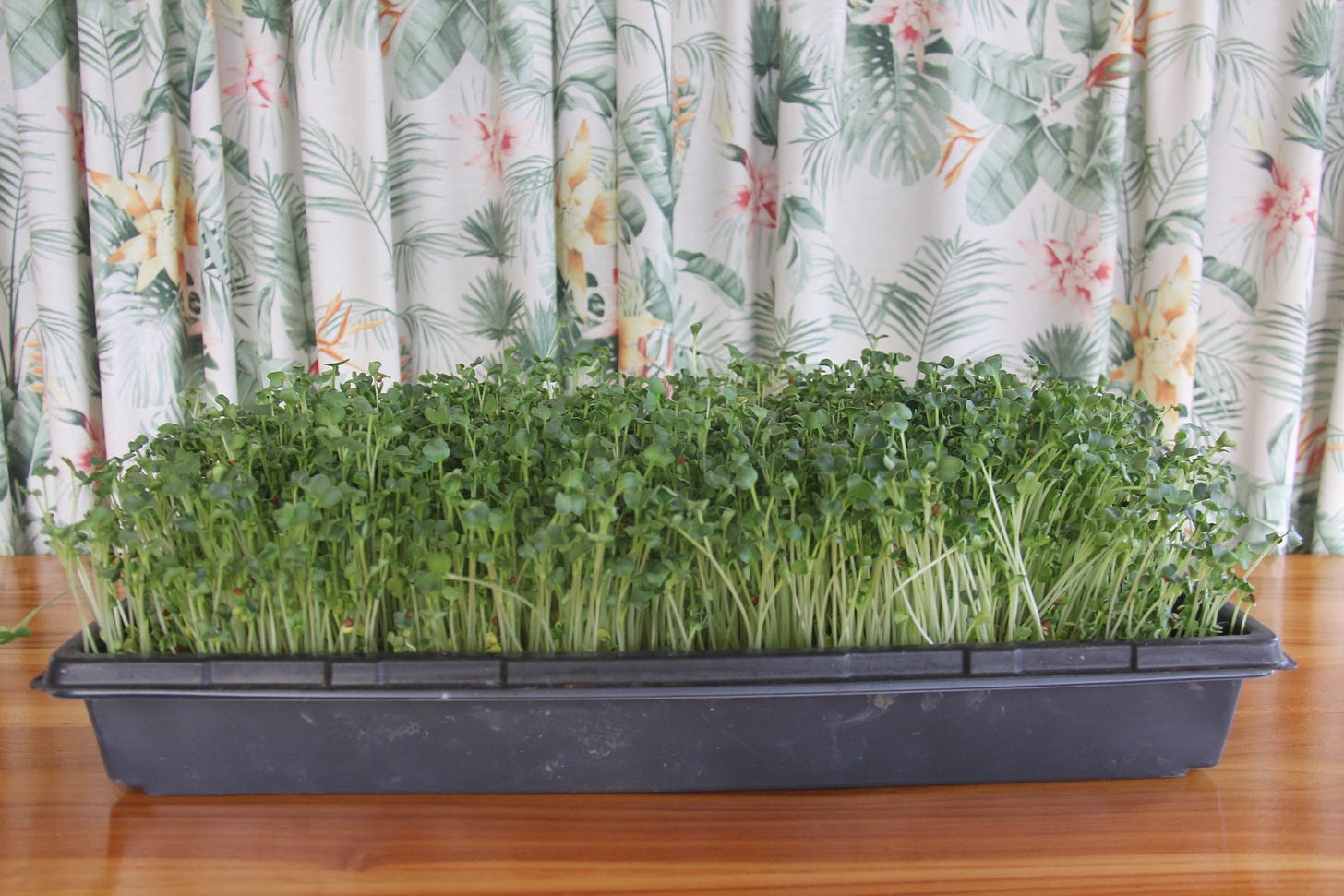This article is best viewed in your Browser
I have tried every possible way to grow sprouts which are nutrient-dense superfoods. What I am going to share with you has proven to be the best overall way, hands down. Here’s how………..
Components I use Indoors or in a Greenhouse
NOTE 1: Buy your supplies locally when possible.
NOTE 2: This sprout growing method works with several different types of sprouting seed types but best with radish seeds which grow faster and bigger than anything I’ve tried. Other possibilities include: arugula, alfalfa, broccoli, wheat grass, mung beans, etc.
NOTE 3: This sprouting setup, because of its high sprout yield, is for those who intend to eat sprouts often and regularly.
2-10”X20” seed starting trays without holes like https://www.amazon.com/s?srs=2595625011&rh=p_89%3ALiving%2BWhole%2BFoods. Drill approximately 24 1/4” holes in one of the 2 trays.
Organic sprouting seeds (1 lb.). I use RADISH seeds because they produce more sprouts faster than any other seeds I have tried and they taste great, a little spicy. Radish seeds also produce more volume (fill more jars) than most other seeds. These work well for me: https://www.amazon.com/Nature-Jims-Radish-Sprout-Seeds/dp/B08HM8B7BH?ref_=ast_sto_dp. Sowing the seeds: Apply radish seeds generously and densely on the supersaturated (soaking wet) peat moss so little peat moss is showing.
Clean PEAT MOSS SUBSTRATE (local garden supply store).
Clean BUCKET
1 gal. WATER, (distilled if possible). Distilled water is the only water I drink or cook with. I then structure the water and add one or more minerals like MSM and/or nutrients. Most other water is contaminated, some a little, most a lot. Store-bought distilled water is sold in plastic containers which I do not recommend. Here is a good, relatively affordable distiller: https://www.amazon.com/Megahome-Countertop-Distiller-Stainless-Collection/dp/B000ANW7HQ
Spray glass bottle or small, 1-gallon SPRAYER like: https://www.amazon.com/Chapin-20004-Pressured-Spraying-Watering/dp/B000E28UQU?ref_=ast_sto_dp&th=1
MASON JARS: Wide-mouth, quart…. One 10”x20” tray will produce 4 quarts of radish sprouts after 5 days of sprouting. After 6-7 days the yield will be 5+ quarts. WARNING: Do NOT rinse your sprouts before storing them in Mason or any other type of jars (no plastic). Sprouts should not be wet at the time of bottling.
Refrigerate your sprouts after placing them in glass containers like Mason Jars.
In Summary:
In one of the 2-10”X20” trays drill about 24-1.25” holes or buy some pre-drilled trays. Place this tray in the tray without holes.
Place 7 or 8 generous hands full of peat moss in a clean bucket. Soak the peat moss thoroughly (super saturate) in water, preferably distilled.
Place about 1” to 1-1/4” of “soaking-wet” peat moss in the tray with holes which is already in the tray without holes. Smooth out peat moss so it is more or less even and level.
Broadcast radish seeds on top of the supersaturated peat moss so you can barely see any peat moss. Gently push the seed into the peat moss but do not bury or cover the seeds.
Place the double-tray of sprouts by a window with good light or under a good quality grow light.
For the first 2 or 3 days (until the seeds start to sprout) spray (2 or 3 times per day) the tops of the seeds to keep them wet. This speeds up germination. I use a 1-gallon, hand-pump sprayer. For the first 2 or 3 days you won’t see much sprouting. For the last 2 days growth is wild and crazy.
After 5 full days cut the sprouts with clean culinary scissors. Do not pull the sprouts out of the peat moss. Replace the tray to where you did the original sprouting. In 2 or 3 more days you should be able to harvest a second, smaller (20% more) crop of sprouts.
Finally, if you like to eat full-grown radishes, you can take your peat moss which still has some un-sprouted seeds, and mix it into some high quality garden soil. I have done this in one of my raised beds and, in about 2 to 3 months, harvested a nice crop of radishes.
This process works best with radish seeds. It also worked well with arugula sprouting seeds but it took twice as long (10 days) and produced a smaller volume of sprouts. I also tried alfalfa seeds. These even took longer to sprout sufficiently (12 - 14 days) and the production volume was even less than the arugula. I have not tried all the different types of sprouting seeds so, if you like my approach to sprouting, you might try some other varieties of sprouting seeds.
Lastly, I do recommend sprouting with radishes first. I have had several excellent successes using radish seeds with this method. My next sprouting adventure using this method will be with broccoli seeds.
Happy sprouting!



